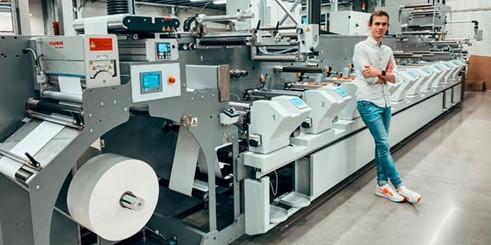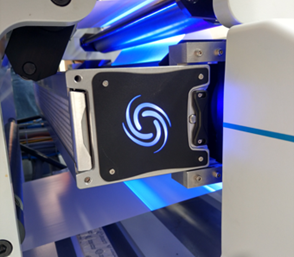What if you could reduce 1/3 of the energy consumption in your factory overnight?
Sustainability has risen on the agenda, but power consumption brings the economic aspect to the table. The economics are driving this change, and at the end of the day the economics are the biggest driver for change. In the past, making sustainability changes was typically more expensive. But today it is possible to meet the economic targets and increase the sustainability initiatives at the same time.
The energy crisis in Europe has changed people’s behavior. Phoseon recently visited a label converter in Europe with eight printing presses and learned that one third of the entire energy consumption of the factory is attributed to the mercury lamps on the presses. If Phoseon were to approach that customer a year ago with energy savings numbers, it would not have been as compelling. But today the energy prices have tripled so printers have become very eager to install LED on the press to replace the mercury. Upgrading to UV LED curing can reduce energy bills by 50-80% overnight with return on investment in well under one year.
Economics are the Biggest Driver
Sustainability has always been an ethical imperative, but now it is an economic necessity. Phoseon Technology will take a closer look at sustainable printing technology and some of the processes required to support it. Companies can reduce carbon footprint through reduced energy consumption, pollution prevention and waste reduction. There are several factors in the printing process that contribute to these factors. The curing technology, the presses, the substrates, the inks, and the factory processes have a significant role to play for sustainability. Through collaboration, cooperation and commitment, people can create a sustainable print technology, and in many cases reduce operating costs.
Phoseon works with customers that run screen, digital inkjet, flexographic, and offset printing processes. Throughout all these processes, we have continued to see pressure on sustainability. Today, all the major brands are requiring their suppliers to deliver more sustainable printing practices. In some cases, these large companies are asking all their printers and converters to eliminate mercury-based curing technology and upgrade to UV LED. This can be a multimillion-dollar investment over a period of a few years. As the pressure for sustainable processes increases, more companies have directors of sustainability that want to see real progress with numbers and auditing for these initiatives.
Embracing Sustainability
Eticod in Poland is a great example of a company that has embraced sustainability not only in printing but also in the way they designed their factory. In the second generation now, Eticod is transforming the self-adhesive label industry with state-of-the-art labels printed on paper, film and foil as well as aluminum and wood. According to Eticod, sustainability starts with small steps, and you need to take many of them to then become fully sustainable.
Their printing house was designed as a passive facility, and the main source of energy is the heat stored in the ground. Vertical boreholes located on their plot have a total length of over 3 km. To ensure the right climate and temperature in the company, they mainly use ground source heat pumps – currently 7 pieces. To obtain the highest efficiency of the system, they use low-temperature capillary water and phase change mats – hidden in walls, but also in ceilings and floors.
Additional support systems are air ground heat exchangers located under the production hall and in green areas with a capacity of over 7,000 m3 per hour. All ventilation uses recuperators, and in winter they use excess heat to heat the parking lots.
In the production hall, they used surface radiators to minimize air movement and reduce dust movement.
As one of few companies, they do not use chillers to cool printing machines, and their own 50,000W photovoltaic power plant allows them to be even more eco-friendly.
Eticod does not have air conditioners, heaters, and traditional light sources. They use 100% LED lamps for lighting. An exceptionally good barrier against excess sun is roller shutters and external blinds connected to the weather station, which react to the external weather situation on an ongoing basis. Thanks to the huge number of sensors, valves and bypasses, they can maintain a constant temperature and humidity regardless of the time of day or year. The whole thing is supervised by a highly intelligent, proprietary control system in the mobile and PC version.
Eticod runs five flexographic presses. They reduce energy consumption by using Phoseon UV LED curing on two of presses instead of traditional mercury lamps. They also have two HP indigo presses in the factory and several converting machines from other vendors. The company has no chillers on any of the machines. Instead, they are using geothermal energy to cool the water for their presses, and they are the only company worldwide to run HP indigo presses without chillers.
“When we made the decision to invest in a new machine, we knew we could only remain competitive if we invested in the latest technology and our future. In opting for Bobst and Phoseon, we liked the perfect combination of two suppliers that have shaped the past and will shape the future of flexography, “
– Aron Huc, Managing Director / Co-Owner of Eticod
LED Curing Brings Sustainability and Cost Savings
When Eticod compared their two newer M5, 10 color Bobst presses (with UV LED curing from Phoseon, inks supplied by Flint) to the older presses (with traditional mercury lamps), the newer presses reduced the energy costs by 70 percent. In addition to the 70% savings, the newer presses with LED have better machine up time, do not require bulb changes, do not require chillers, and no ozone is generated. The eco-friendly inks from Flint have much better adhesion and current performance at higher speeds than traditional inks so they're very happy with this combination.
70% less energy consumption than a traditional press
No spare parts
No ozone = no under pressure, better thermal dynamics in the plant
Better machine up time (no heating up or cooling down of lamps)
No mercury (no hazardous waste)
Smaller carbon footprint
Ecocure Inks from FLINT (Better adhesion and curing performance at higher speeds)
Mercury systems need to be running all the time, while LED is instant on off and can be used as needed. With mercury there is a lot of heat to manage, stray light, components that deteriorate over time, and a very short lifetime. In contrast, LED brings stability and has a very long lifetime.
What is the Future of LED Technology?
It is clear that the economic factor is further driving the change towards sustainability, which is already boosted by customer and legislative demand.
Phoseon continues its focus on R&D; last year Phoseon introduced the industry's first fully air-cooled system for flexographic UV printing systems and continues to collaborate with customers to broaden their range of products. With Phoseon’s wide portfolio and continuous development, the company is ready to meet growing demand for sustainable LED technology in the print industry.
Phoseon Nexus ONE™ UV LED Curing System
To learn more about creating a sustainable print technology and processes from Phoseon and ecosystem partners, please attend the recorded webinar from Future Print https://youtu.be/RrtlElrI9pE



